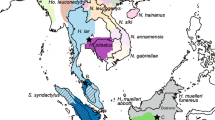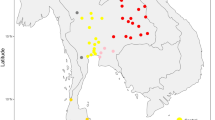Abstract
The HLA class I and class II loci are the most highly polymorphic coding regions in the human genome. Based on the similarity of the coding sequences of alleles between species, it has been claimed that the HLA polymorphism is ancient and predates the separation of human (Homo) and chimpanzee (Pan), 4–7.4 Myr ago. Analysis of intron sequences, however, provides support for a more recent origin and for rapid generation of alleles at the HLA class II DRB1 locus. The human DRB1 alleles can be divided into groups (allelic lineages); most of these lineages have diverged from each other before the separation of Homo and Pan. Alleles within such a lineage, however, appear to be, on average, 250,000 years old, implying that the vast majority (greater than 90%) of the more than 135 contemporary human DRB1 alleles have been generated after the separation of Homo and Pan. The coalescence time of alleles within allelic lineages indicates that the effective population size (Ne) for early hominids (over the last 1 Myr) was approximately 104 individuals, similar to estimates based on other nuclear loci and mitochondrial DMA. With a single exception, the genetic mechanisms (gene conversion and point mutation) that have diversified the exon-2 sequences do not appear to extend into the adjacent intron sequences. The part of exon 2 encoding the (β-sheet evolves in concert with the surrounding introns, while the α-helix appears to have been subjected to gene conversion-like events, suggesting that such exchange events are highly localised and occur over extremely short sequence tracts.
This is a preview of subscription content, access via your institution
Access options
Subscribe to this journal
Receive 12 print issues and online access
$209.00 per year
only $17.42 per issue
Buy this article
- Purchase on Springer Link
- Instant access to full article PDF
Prices may be subject to local taxes which are calculated during checkout
Similar content being viewed by others
References
Kappes, D. & Strominger, J.L. Human class II major histocompatibility complex genes and proteins. Ann. Rev. Biochem. 57, 991–1028 (1988).
Trowsdale, J. “Both man & bird & beast”: comparative organization of MHC genes. Immunogenetics 41, 1–17 (1995).
Arden, B. & Klein, J. Biochemical comparison of major histocompatibility complex molecules from different subspecies of mus musculus: Evidence for trans-specific evolution of alleles. Proc. Natl. Acad. Sci. USA 79, 2342–2346 (1982).
Klein, J. Origin of major histocompatibility complex polymorphism: the trans-species hypothesis. Hum. Immunol. 19, 155–162 (1987).
Figueroa, F ., Günther, E. & Klein, J. MHC polymorphism pre-dating speciation. Nature 335, 265–267 (1988).
Satta, Y., Takahata, N., Sochönabach, C., Gutknecht, J. & Klein, J. in Molecular Evolution of the Major Histocompatibility Complex (eds Klein, J. & Klein, D.) 51–62 (Springer Verlag, Berlin-Heidelberg, 1991).
Ayala, F.J., Escalante, A., O'hUigin, C. & Klein, J. Molecular genetics of speciation and human origins. Proc. Natl. Acad. Sci. USA 91, 6787–6794 (1994).
Ayala, F.J. The myth of Eve: molecular biology and human origins. Science 270, 1930–1936 (1995).
Ayala, F.J. & Escalante, A.A. The evolution of human populations: A molecular perspective. Mol. Phyl. Evol. 5, 188–201 (1996).
Gyllensten, U.B., Sundvall, M. & Erlich, H.A. Allelic diversity is generated by intraexon sequence exchange at the DRB1 locus of primates. Proc. Natl. Acad. Sci. USA 88, 3686–3690 (1991).
Gyllensten, U., Bergström, T., Josefsson, A., Sundvall, M. & Erlich, H.A. Rapid allelic diversification and intensified selection at antigen recognition sites of the MHC class II DPB1 locus during hominoid evolution. Tissue Antigens 47, 212–221 (1996).
Titus-Trachtenberg, E.A., Rickards, O., De Stefano, G.F. & Erlich, H.A. Analysis of HLA class II haplotypes in the Cayapa Indians of Ecuador: a novel DRB1 allele reveals evidence for convergent evolution and balancing selection at position 86. Am. J. Hum. Genet. 55, 160–167 (1994).
Mack, S.J. & Erlich, H.A. HLA class II polymorphism in the Ticuna of Brazil: Evolutionary implications of the DRB1*0807 allele.Tissue Antigens 51, 41–50 (1998).
Hughes, A.L. & Nei, M. Pattern of nucleotide substitution at major histocompatibility complex class I loci reveals overdominant selection. Nature 335,167–170 (1988).
Hughes, A.L. & Nei, M. Nucleotide substitution at major histocompatibility complex class II loci: evidence for overdominant selection. Proc. Natl. Acad. Sci. USA 86, 958–962 (1989).
Begovich, A.B. . et al. Polymorphism, recombination, and linkage disequilibrium within the HLA class II region. J. Immunol. 148, 249–258 (1992).
Gorski, J. & Mach, B. Polymorphism of human la antigens: gene conversion between two DRB loci results in a HLA-D/DR specificity. Nature 322, 67–70 (1986).
Marsh, S.G. & Bodmer, J.G. HLA class II region nucleotide sequences, 1995. Tissue Antigens 46, 258–280 (1995).
Sneath, P.H.A. & Sokal, R.R. Numerical Taxonomy (freeman, San Francisco, 1973).
Saitou, N. & Nei, M. The neighbor-joining method: a new method for reconstructing phylogenetic trees. Mol. Biol. Evol. 4, 406–425 (1987).
Jukes, T.H. & Cantor, C.R. . in Mammalian Protein Metabolism (ed. Munro, H.N.) 21–32 (Academic Press, New York, 1969).
Svensson, A.C., Setterblad, N., Sigurdardo′ttir, S., Rask, L . & Andersson, G . Primate DRB genes from the DR3 and DR8 haplotypes contain ERV9 LTR elements at identical position. Immunogenetics 41, 74–82 (1995).
Svensson, A.C., Setterblad, N., Pihlgren, U., Rask, L. & Andersson, G. Evolutionary relationship between human major histocompatibility complex HLA-DR haplotypes. Immunogenetics 43, 304–314 (1996).
Li, W.H., Ellsworth, D.L., Krushkall, J., Chang, B.H.J. & Emmett, D.H. Rates of nucleotide substitution in primates and rodents and the generation-time effect hypothesis. Mol. Phyl. Evol. 5, 182–187 (1996).
Satta, Y., Mayer, W.E. & Klein, J. Evolutionary relationship of HLA-DRB1 genes inferred from intron sequences. J. Mol. Evol. 42, 648–657 (1996).
Holmes, E.C., Pesole, G. & Saccone, C. Stochastic models of molecular evolution and the estimation of phylogeny and rates of nucleotide substitution in the hominoid primates. J. Hum. Evol. 18, 774–794 (1989).
Horai, S. . et al. Man's place in Hominoidea revealed by mitochondrial DNA genealogy. J. Mol. Evol. 35, 32–43 (1992).
Horai, S., Hayasaka, K., Kondo, R., Tsugane, K. & Takahata, N., African origin of modern humans revealed by complete sequences of hominoid mitochondrial DNAs. Proc. Natl. Acad. Sci. USA 92, 532–536 (1995).
McConnell, T.J., Talbot, W.S., Mclndoe, R.A. & Wakeland, E.K. The origin of MHC class II gene polymorphism within the genus Mus. Nature 332, 651–654 (1988).
Nathenson, S.G., Geliebter, J., Pfaffenbach, G.M. & Zeff, R.A. Murine major histocompatibility complex class-l mutants: Molecular analysis and structure-function implication. Ann. Rev. Immunol. 4, 471–502 (1986).
Wu, S., Saunders, T. & Bach, F. Polymorphism of human la antigens generated by reciprocal exchange between two DRβ loci. Nature 324, 676–679 (1986).
Ripley, L.S. . in Molecular Evolution of the Major Histocompatibility Complex (eds Klein, J. & Klein, D.) 63–94 (Springer-Verlag, Berlin-Heidelberg, 1991).
Ohta, T. Gene conversion vs point mutation in generating variability at the antigen recognition site of major histocompatibility complex loci. J. Mol. Evol. 41,115–119 (1995).
Mayer, W.E. . et al. Nucleotide sequences of chimpanzee MHC class I alleles: evidence for trans-species mode of evolution. EMBO J. 7, 2765–2774 (1988).
Maynard Smith, J. & Haigh, J. The hitchhiking effect of a favourable gene. Genetical Res. 23, 23–35 (1974).
Kaplan, N.L., Hudson, R.R. & Langley, C.H. The hitchhiking effect revisited. Genetics 123, 887–899 (1989).
Charlesworth, B., Morgan, M.T. & Charlesworth, D. The effect of deleterious mutations on neutral molecular variation. Genetics 134, 1289–1303 (1993).
Strobeck, C. Expected linkage disequilibrium for a neutral locus linked to a chromosomal arrangement. Genetics 103, 545–555 (1983).
Kaplan, N.L., Darden, T. & Hudson, R.R. The coalescence process in models with selection. Genetics 120, 819–829 (1988).
Hudson, R.R. & Kaplan, N.L. The coalescence process in models with selection and recombination. Genetics 120, 831–840 (1988).
Tajima, F. Statistical methods for testing the neutral mutation hypothesis by DNA polymorphism. Genetics 123, 585–595 (1989).
Takahata, N. Allelic genealogy and human evolution. Mol. Biol. Evol. 10, 2–22 (1993).
Takahata, N. & Satta, Y. Footprints of intragenic recombination on silent nucleotide diversity at HLA loci. Immunogenetics (in press).
Takahata, N. & Satta, Y. Evolution of the primate lineage leading to modern humans: Phylogenetic and demographic inferences from DNA sequences. Proc. Natl. Acad. Sci. USA 94, 4811–4815 (1997).
Harding, R.M. et al. Archaic african and asian lineages in the genetic ancestry of modern humans. Am. J. Hum. Genet. 60, 772–789 (1997).
Cann, R.L., Stoneking, M. & Wilson, A.C. Mitochondrial DNA and human evolution. Nature 325, 31–36 (1987).
Vigilant, L., Stoneking, M., Harpending, H., Hawkes, K. & Wilson, A.C. African populations and the evolution of mitochondrial DNA. Science 253, 1503–1507 (1991).
Li, W.-H. & Saddler, L.A. Low nucleotide diversity in man. Genetics 129, 513–523 (1991).
Fullerton, N., Harding, R.M., Boyce, A.J. & Clegg, J.B. Molecular and population genetic analysis of allelic sequence diversity at human β-globin locus. Proc. Natl. Acad. Sci. USA 91, 1805–1809 (1994).
Hammer, M.F. A recent common ancestry for human Y chromosomes. Nature 378, 376–378 (1995).
Kumar, S., Tamura, K. & Nei, M. MEGA: Molecular evolutionary genetics analysis, version 1.0.Comput. Appl. Biosci. 10, 189–191 (1994).
Nei, M. & Gojobori, T. Simple methods for estimating the numbers of synonymous and nonsynonymous nucleotide substitutions. Mol. Biol. Evol. 3, 418–426 (1986).
Hickson, R.E. & Cann, R.L. Mhc allelic diversity and modern human origins. J. Mol. Evol. 45, 589–598 (1997).
Author information
Authors and Affiliations
Rights and permissions
About this article
Cite this article
Bergström, T., Josefsson, A., Erlich, H. et al. Recent origin of HLA-DRB1 alleles and implications for human evolution. Nat Genet 18, 237–242 (1998). https://doi.org/10.1038/ng0398-237
Received:
Accepted:
Issue Date:
DOI: https://doi.org/10.1038/ng0398-237
This article is cited by
-
Genetic diversity of the Thao people of Taiwan using Y-chromosome, mitochondrial DNA and HLA gene systems
BMC Evolutionary Biology (2019)
-
Interactions of HLA-DR and Topoisomerase I Epitope Modulated Genetic Risk for Systemic Sclerosis
Scientific Reports (2019)
-
Meta-populational demes constitute a reservoir for large MHC allele diversity in wild house mice (Mus musculus)
Frontiers in Zoology (2018)
-
Genomic structure of the horse major histocompatibility complex class II region resolved using PacBio long-read sequencing technology
Scientific Reports (2017)
-
Computer simulation of human leukocyte antigen genes supports two main routes of colonization by human populations in East Asia
BMC Evolutionary Biology (2015)



